History of Rowing Victoria Inc
- Table of Contents
- Introduction
- Chapters
- 1: Rowing in a young Victoria 1838-1859
- 2: Formation of the Association 1860-1875
- 3: Growth of the Sport 1876-1889
- 4: Years of great success 1890-1899
- 5: The rise of Australian Henley 1900-1909
- 6: The War Years 1910-1919
- 7: Women's rowing and the modern era 1920-1929
- 8: The Depression Rebuild 1930-1939
- 9: War and rebuilding 1940-1949
- 10: Expansion years 1950-1959
- 11: The search for international success 1960-1969
- 12: Combining the Associations and lightweight success 1970-1979
- 13: The new national program 1980-1989
- 14: Golden years 1990-1999
- 15: Professionalism 2000-2009
- 16: Yet More Growth 2010-2019
- 17: Changing Times 2020-2026
- Appendices
- 1: Life Membership and other important awards
- 2: Patrons and Presidents
- 3: Office Bearers
- 4: Clubs and their histories
- 5: The Oarsmen's Centotaph and WWI Roll of Honour
- 6: WWII Roll of Honour
- 7: Premierships
- 8: State Championships
- 9: Hall of Fame Inductees
- 10: Victorian Olympians
- 11: International representation
- 12: Intercolonial and Interstate Racing
- 13: School rowing
- 14: University rowing
- 15: Histories of Victorian Rowing
- 16: Annual Reports
This chapter is under construction
11: The search for international success 1960-1969
Chapter 11 page 1 2 3 4
Women's rowing in Victoria was on its knees at the start of this decade. Through some excellent work by many people, it recovered well and by 1966 was competitive again. Special mention must be made of Roy Scutcheon and the rowers from Nestles in Warrnambool who maintained a good standard through the first part of 1960s and then Margaret Mackenzie who moved to Melbourne in the mid 1960s and coached and rowed in winning Victorian crews. She was a significant contributor to the resurrection of women’s rowing in Victoria. Behind the scenes, she engineered the introduction of an interstate lightweight four championship which was known as the Victoria Cup.
After so much success with little organisational input beyond appointing national selectors, and holding selection events as required for Empire Games and Olympic Games, rowers entered the 1960s with great expectations. Initially, Australian crews were insulated from the new training methods as many coaches continued to train crews to meet 3 mile races requirements. However as we trained to meet the shorter 2000m courses, many failed to maintain the aerobic base necessary for 2000m racing.
Sadly, we were to find out that the rest of the world had adopted new coaching and training methods, and a revolution in equipment design had taken place since 1956. International success had to wait until later in the decade. We were not served well by those in charge of the sport at that time.
The 1960 Olympic Regatta saw the introduction of lighter and more revolutionary shaped boats. The Australians raced in older styled boats including the only stern coxed pair at the regatta which was also twice the weight of the lightest pair in the competition. This change was even more apparent at 1964 Olympic regatta and more on this later.
The Australians returned home with much useful knowledge - the scientific approach of the Germans, the rigorous approach of the Canadians, the use of lighter boats with differing rigs and the need for greater racing experience. However the key lesson of 1960 was the need for greater acclimatisation and international competition. The eight's coach in his report included the following recommendations:
"The need for a longer acclimatisation period at or near the venues I cannot stress too strongly. A stricter check on food available and its suitability to particular sports would help to maintain a diet already established in Australia. I am sure that oil cooked preparations at Rome did not suit the average Australian. Weight and energy loss are a vital factor in my estimates.
"International competition prior to future Olympic competition gives atmosphere and edge to any crew and should be included in the programme of rowing teams if possible. European crews race in tough competition very frequently and their standard was very high as a result. Our isolation of course makes this difficult to arrange."
These recommendations form a key part of the preparation of any modern crew. So the message came home from 1960 Olympic Games but no heed was taken of it.
We again sent many crews away to the 1964 Olympic Games and returned again with no success. This time David Boykett, a member of the men's eight, and fellow Mercantile member Bob Aitken, took matters into theirown hands and imported a new Italian Donoratico eight.
The commentary for the 1964 Olympic page on this website provides further details.
The modern designed racing boats which were used by other nations with mixed success in the 1960 Games, and successfully at the 1962 World Championships, were used extensively at these Games. Australia again used older designs to its detriment.
The men's eight used a new boat which was donated by the Gillette Company and so bore its name. Sydney boat builders Sargent and Burton incorporated new design features which they thought would counter the new international trends in boat building. In fact some of these Australian modifications lacked empirical wisdom proving that not all change is for the good. The boat was delivered just one week before the shipping date for Tokyo. Anxious trials revealed that the stern dragged in the water with conspicuous adverse effect. The boat was therefore discarded.
Hastily a repaired boat available from another Sydney boat builder George Towns was renamed Gillette and shipped without even the possibility of first trying it on the water. The great advances in boat design had simply left Australia behind. The Americans, led by John Kelly Jnr, had commissioned the Italian boat-builder Donoratico to build several boats incorporating new technology including the moulding of the shell rather than tacking it to the frame.
The skin of the poorly constructed Australian eight flexed like a diaphragm and despite some quick-fix attempts the boat, if not the crew, was out of its class. For the petite final the men's eight was loaned use of one of the American Donoratico boats, the John B Kelly. Although rowing in it for the first time, and in no way being adapted for the Australians, the crew was able to row its fastest time by far. All appreciated the experience and realised the need to compete on even terms with equipment, rowing technique and training.
Bob Aitken and David Boykett purchased and imported an Italian Donoratico eight to Australia. The mould was quickly copied by Australian boat-builders. Considerable controversy arose from the use of the new craft and there were widespread calls from throughout Australia for the boat to be barred. Coach Alan Jacobsen stated in his report:
"It was quite clear that an improvement of at least 10 seconds could have been possible if the crew had trained in the boat, and it was equally obvious that our Towns boat had a disadvantage of 15 seconds to 20 seconds."
Sydney Rowing Club also imported a Stampfli four which remained the best four in Australia for some 20 years.
The 1968 Olympic rowing team was severely reduced by the lack of prior success and Australia at least overcame the equipment changes by then. The changed training methodology would take until the 1980s to fully resolve.
1959-60
Much of the 1960 season saw a great deal of attention placed on the Test Races which would decide the crews for the 1960 Summer Rome Olympics. These included the coveted King’s Cup race which was to decide the eight-oared crew, a series of races on the Nepean River in Penrith, and the final races on Lake Wendouree, Ballarat.
The King’s Cup Regatta is already steeped in tradition and history, and will always produce ferocious competition from patriotic oarsmen. The prospect of Olympic Selection for the winning crew served only to make the racing more passionate, and Western Australia seemed most able to make use of this incentive. They stormed down the 2000 meter course in a time of 5:54, with Victoria many lengths of clear water back.
Victoria would see their oarsmen qualify for Olympic racing at the second series of Test Races at Penrith, when the crew from Melbourne University were victorious in the Coxless Pair. The remaining races were held on Lake Wendouree, and saw a composite crew from Banks and Melbourne University qualify for the Coxless Pair position.
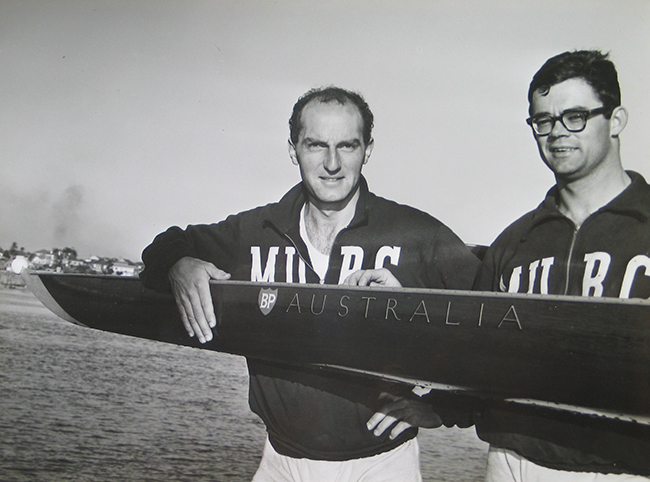
Olympic Pair John Hunt and Terry Davies
A standout feature of the Senior Premiership was the keen competition between two composite crews. One comprising of oarsmen from Albert Park, Melbourne University, Yarra Yarra and Mercantile, and the other crew made up of athletes from Banks and Mercantile. These talented crews offered great spectacles of racing throughout the season and pressed the Mercantile Club crew on many occasions. Mercantile would ultimately claim victory in the Senior Premiership.
Another crew of interest was Albert Bell's Corio Bay senior four of bow David John, 2 David Caithness, 3 Derek Norwood, stroke David Ramage and cox Phillip Sarah. This crew won the senior four championship this season and the following two seasons, along with a NSW Championship four and the inaugural National Championships coxed four in 1962. An excellent crew to come out of Geelong.
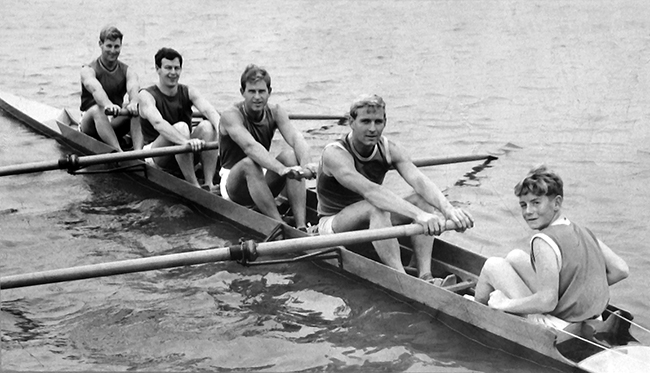
Victorian Champion Four from Corio Bay
Hawthorn Rowing Club won its first Junior Premiership in 25 years. Corio Bay had the fantastic privilege of claiming both the Lightweight and Country Premiership.
Schoolboy participation in regattas continued this season and was beneficial for organizing committees and the schools themselves. The Scotch-Mercantile Regatta again attracted large amounts of entries from schoolboy and club crews but failed to attain its usual numbers thanks to the early date of the King’s Cup race.
Melbourne University were unable to trouble the talented Sydney University eight-oared crew over 2 miles at the annual Oxford and Cambridge Cup, whilst Geelong College enjoyed a very narrow victory in a close and exciting final at the APS Head of the River Regatta.
Whilst Victorian women's rowing was at a low ebb, a crew did represent the State at the Interstate Championships in Brisbane, albeit without success.
1960-61
As discussed at the top of this page, the 1960 Olympic Games were a disappointment for Australia and the Victorians in the team. The team's best chance of success was Stuart Mackenzie but he was too ill to race. The best crew was the NSW based coxed four which finished fifth. All other Australian crews were eliminated in the repechages.
Another encouraging year for Victorian Rowing was had on the domestic scene. The Victorian Championship Eights race was a cracker with Mercantile winning by only half a length from Corio Bay. The margin ensured that key Corio Bay oarsmen were included in the eight.
The highlight of the season was no doubt the valiant performance of the Victorian Eight-Oared Crew who were successful in regaining the King’s Cup in a closely contested battle against New South Wales. The crew was remembered by onlookers to exhibit perfect rowing form, rating an upbeat 36 strokes per minute whilst maintaining perfect length and easy rhythm, no doubt due to the supreme talent of stroke man, David Boykett. Perhaps this fine display of rowing was aided in part by the use of American-built Pocock Oars, which the crew had the privilege of using for the race.
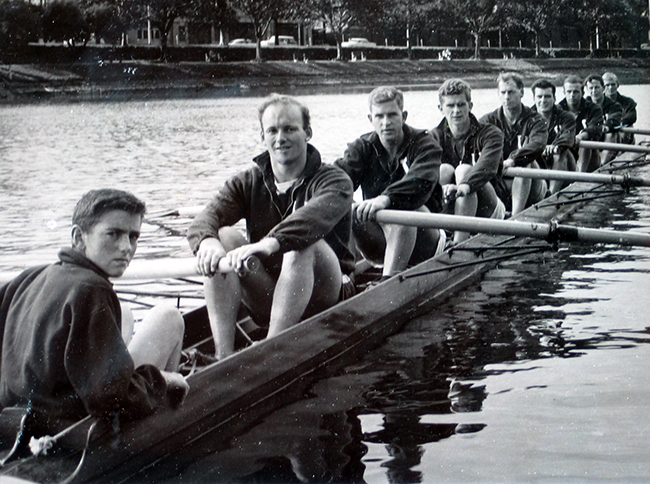
Victorious Victorian Eight
Bow: John Castles, 2: David Caithness, 3: Simon Newcomb, 4: Martin Tomanovits, 5: William Arnold, 6: Graeme McCall, 7: Derek Norwood, Str: David Boykett, Cox: David Palfreyman
One might also say the supreme performance from the Victorian Crew could be attributed to tough lessons learned at the Rome Olympic Games, where the best Victoria and Australia had to offer struggled to contest in a field boasting fitter, more experienced, and better equipped international oarsmen.
Rowing enthusiasts in Victoria never had to look far to find exciting and competitive racing on their doorstep, with Mercantile Rowing Club always delivering impressive and consistent performances at domestic regattas throughout the season. They again won the treble- Senior, Junior and Lightweight Premiership, a fine performance and the second time the club has won the treble since the Lightweight Premiership was introduced in 1948. Corio Bay claimed the Country Premiership for the second successive year.
Melbourne University were unable to challenge for the Oxford and Cambridge Cup at the University Boat Race when they had the misfortune of losing their bowman when they were well placed half way through the race.
School rowing continued to grow this year, with three new schools contesting the APS Head of the River for the first time- Caulfield Grammar, Brighton Grammar, and St. Kevin’s College. Wesley College emerged victorious in the field of nine crews by a narrow margin from Scotch College.
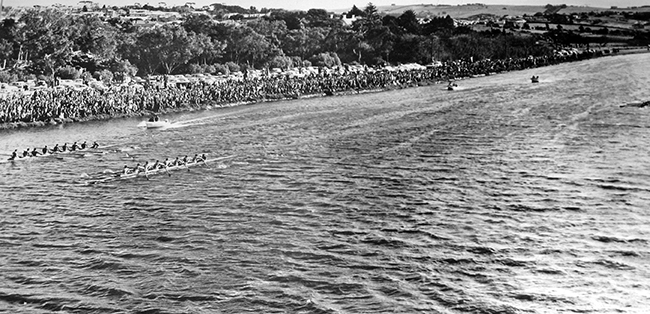
Wesley and Scotch battle it out on the Barwon in the Head of the River.
Women's rowing was again at a low ebb but Victoria were soundly beaten by NSW on the Parramatta River. The NSW crew contained Margaret Mackenzie (then Agnew) who would later become a key part of the Victorian women's rowing revival.
1961-62
This season was remembered as aptly exciting, engaging and rewarding for rowers, officials and rowing enthusiasts alike. From fierce competition amongst oarsmen for international representation with the inaugural World Championships in Lucerne and the British Empire and Commonwealth Games in Perth. At this stage, there was much emphasis on the Commonwealth Games.
There greater number of regattas to the domestic calendar, and the splendid performance of Victorian oarsmen, gave Victorian rowing had much to celebrate.
Throughout the season Victoria witnessed the meteoric rise to success of Banks Rowing Club in senior rowing to topple Mercantile Rowing Club who were almost untouchable over the previous decade. Arguably their most successful season since their foundation some 95 years prior, they were victorious in their first senior eight oared event since 1920, their first eight-oared championship since 1898, and their first ever Senior Premiership. In addition Banks came close to winning the tightly contested Junior Premiership, finishing in second place. Much of this success was attributed to the leadership of Captain Neville Howell.
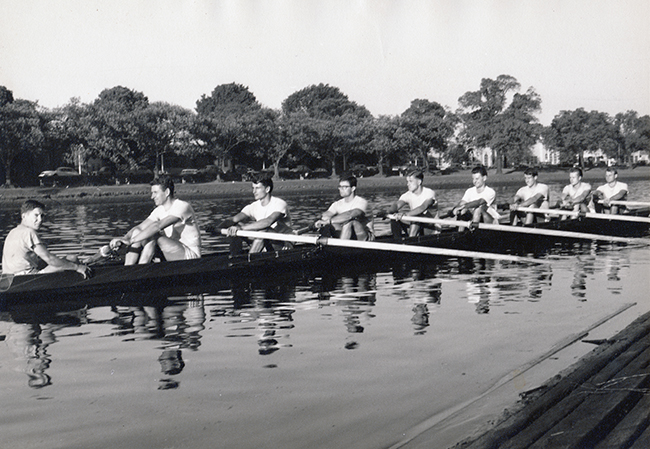
Banks Rowing Club - Victorian Champion Eight
Bow: Ian Douglas, 2: Brian J Vear, 3: Jack T Donaldson. 4: Charles J Lehman, 5: Duchan Stankovich, 6: Terry R Davies, 7: Paul M Guest, Str: W Neville Howell, Cox: Graeme Norton, Coach: Alan N Jacobsen
Neville Howell played a pivotal role in what was his fifth King’s Cup victory in ten races. The King’s Cup Regatta was held at Lake Wendouree on the Olympic Course. The Victorian Eight-Oared Crew rowed a magnificent race to take the lead from West Australia in the last 500m of the race, rating a blistering 42 strokes per minute to finish with half a length to spare.
Victoria also enjoyed a comfortable win in the Penrith Cup, never troubled by the challenge from the formidable New South Wales Crew.
The presentation of trophies was carried out by Dr. Clive Disher, stroke of the A.I.F crew which won the King’s Cup for Australia in 1919.
Significantly, the First Australian National Championships were also conducted at Lake Wendouree over Easter, and drew the most fearsome rowers Australia had to offer. The event was a roaring success thanks to the assistance and co-operation of race officials in Ballarat. The event served the dual function of providing test races for selection of crews for the British Empire and Commonwealth Games.
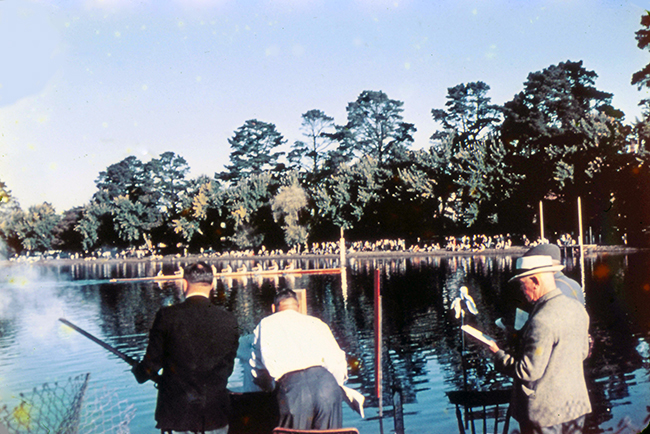
Mercantile taking out the National Championship Lightweight Eight showing judge and commentator
This season saw the triumph of schoolboy rowing, when the Scotch-Mercantile Regatta held on the Upper Yarra in March proved to be the largest rowing regatta ever held in Australia with 940 oarsmen competing in 104 events.
The Victorian women's four narrowly lost to the dominant NSW crew on Albert Park Lake.
1962-63
Victorians could happily celebrate the international success of their oarsmen this season, as the eight-oared crew which won the Australian Championships last year, were picked to represent Australia at the 1962 British Empire and Commonwealth Games in November. The flagship boat was the Men’s Eight and they did not disappoint, winning a gold medal at the event, this was soon followed by the Victorian four with Coxswain which claimed silver medals. The Games truly allowed Victorian Rowing to shine bright.
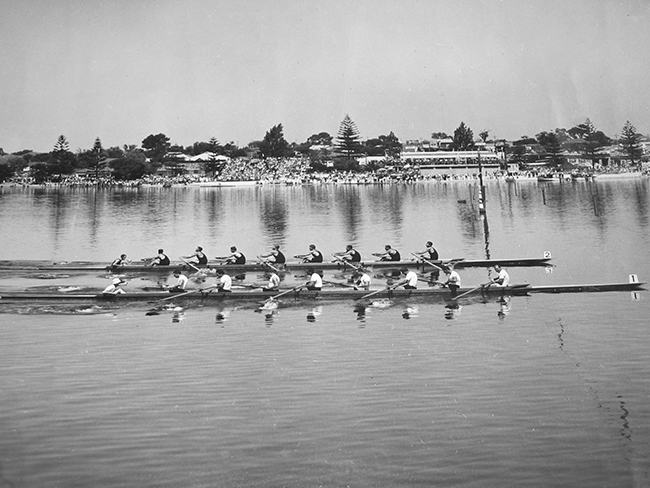
Narrow win by the Victorian based Australian eight at 1962 Empire and Commonwealth Games
Victorians would also represent Australia at the 1962 World Rowing Championships in Lucerne, Switzerland, where representatives would row in the Eight-Oared Crew and Four with Coxswain, placing fifth in the final of each of their respective events against the best crews in the world.
Mercantile won the State Eight Championship at Ballarat from Banks by only half a length..
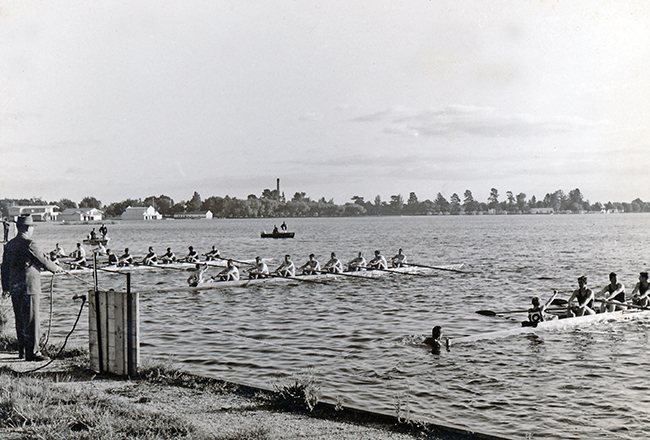
Start of the State Championships at Ballarat
Note the method of boat holding in the chilly Ballarat weather
The state would go on to experience more victory on the Interstate Scene, when for the third time in succession, Victoria would emerge triumphant in the King’s Cup. The race was described by many to be one most thrilling in recent history, with the Victorian crew needing to execute a blistering sprint finish to see off the challenge of the powerful New South Wales Crew to win by half a canvas. The Victorian Lightweight Four and Single Sculler would perform bravely to achieve second place finishes in the Penrith Cup and President’s Cup respectively.
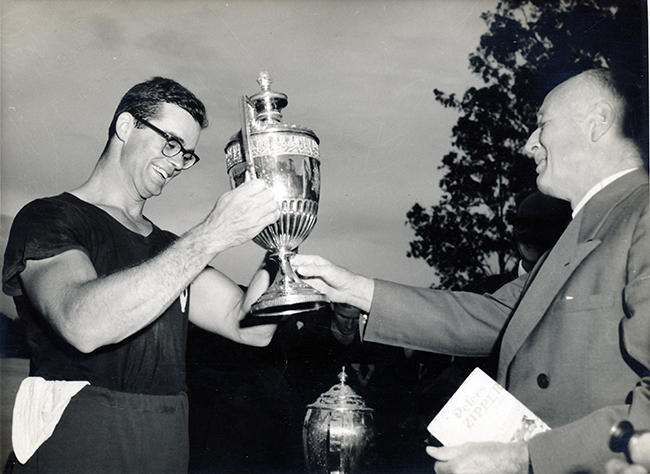
Terry Davies is presented with the King's Cup in 1963
Terry Davies, who ably stroked the King’s Cup Crew to a thrilling win, could be accredited in part with Banks Rowing Club winning the Senior Premiership for the second year in succession, when he took over the stroke seat of the Banks Senior Eight following the retirement of the great Neville Howell. Banks would also go on to win the tightly contested Junior Premiership, narrowly taking it from Mercantile Rowing Club, who also won the Lightweight Premiership.
Melbourne University had the privilege of hosting the Australian Universities Rowing Championships, and rowed spectacularly to win the Oxford and Cambridge Cup for Eight-Oared Crews, and the Sir Fred J. Schonnell Cup for Lightweight Four-Oared Crews.
Scotch College would win the APS Head of the River Regatta, tightly contested by ten competitive schoolboy crews.
The Victorian women's four were still unable to defeat the dominant NSW crew finishing last in Brisbane. Of note was the introduction of the Women's Interstate Sculling Championship for Nell Slatter Cup. Victoria was not represented.
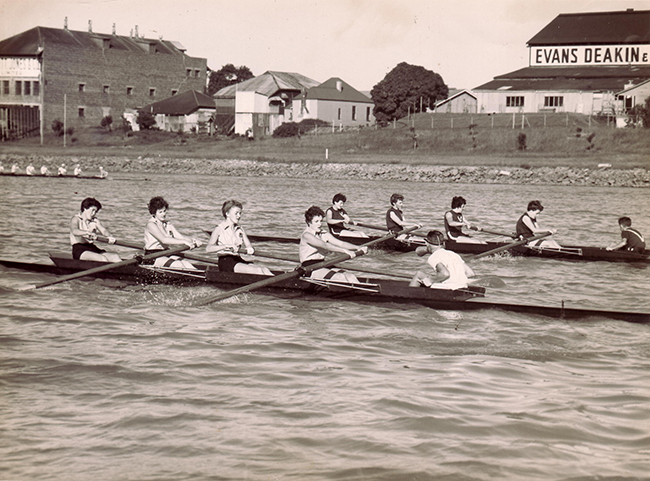
The start of 1963 Interstate Women's Four race
1963-64
The season saw a unique twist on the King’s Cup Regatta, as the decision was made that the event would include test races for the eight-oared crew and small boats to gain Australian representation in all rowing events at 1964 Olympic Games in Tokyo.
This format worked out well for Victoria, as a result gaining representation in four Olympic events out of the total seven. The Eight-Oared Crew and Single Scull were the first to secure their places, on the back of victory in the King’s Cup and President’s Cup respectively. They had support in abundance in the form of the supporting crew led by Tom Rodda and Noel Wilkinson, who made the pilgrimage to the regatta held in New South Wales on the Nepean River.
Six weeks later, a Coxless Four from Mercantile Rowing Club and a Coxed Pair from Nagambie Rowing Club would follow in qualification.
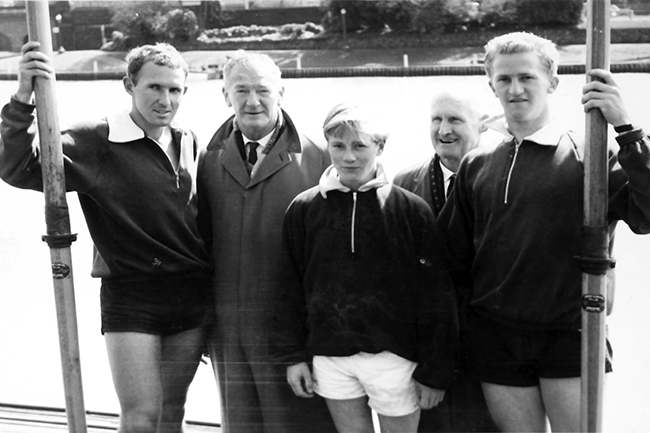
1964 Olympic coxed pair from Nagambie
From the left, Bruce Richardson, Alf Lodding (unofficial coach), Wayne Gammon, Ray Todd (friend of crew), Neil Lodding
The unbridled success of the King’s Cup crew was highlighted when it was announced they had gained first place in the grading of the Olympic Rowing Squad, a testament to their calibre and guidance of coach Alan Jacobson. Furthermore, Victorian Alex McLeish would be appointed rowing manager for the 1964 Olympic Team and Robert Aitken a member of the jury.
The Victorians also won the Penrith Cup for lightweights fours and the President's Cup for sculls. The stroke of the lightweight four was David Palfreyman who had previously coxed the winning Australian and Victorian eights in 1962. He would later race open weight for both Victoria and Australia. On a sad note, three man Jeff Wylie would die after the championships in a motor vehicle accident. He was the energetic club Captain for Mercantile at that time.
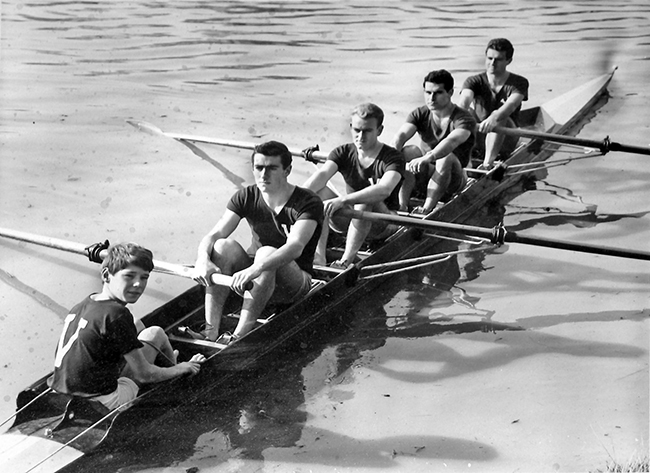
1964 winning lightweight four
Bow: Peter McC Doyle, 2: George Xouris, 3: Jeff Wylie, Str: David Palfreyman, Cox: Chris Fordyce, Cchs: William Wallace & Norman Cairnes
The latter half of the season saw the formation of an eight-oared crew from Wendouree Rowing Club, performing notably well on the domestic scene with a first place in the Country Championship final. The culmination of the season saw Mercantile Rowing Club claim the Senior Division Premiership, and Essendon Rowing Club convincingly win the Junior Division on the back of a racing calendar which saw them persist with large entries at all regattas.
Melbourne Grammar executed a fine race to win the Head of the River on the Barwon, a length clear of Geelong College. Melbourne would fall short of winning the Oxford and Cambridge Cup at the Annual Australian Universities boat race, finishing the three-mile race on the Huon River, Tasmania just 5.4 seconds behind Sydney University.
The women's Interstate Championships again revealed the strength of the NSW crews. There were only NSW scullers racing for the Nell Slatter Cup and the NSW four won easily. The Victorian four finished last, well back.
1964-65
Victorians represented Australia in the 1964 Tokyo Olympic Games, rowing the Eight, Four with Coxswain, Pair with Coxswain and Single Scull. Unfortunately, no crews were able to qualify for a final. A discussion of the issues involved can be found at the top of this page.
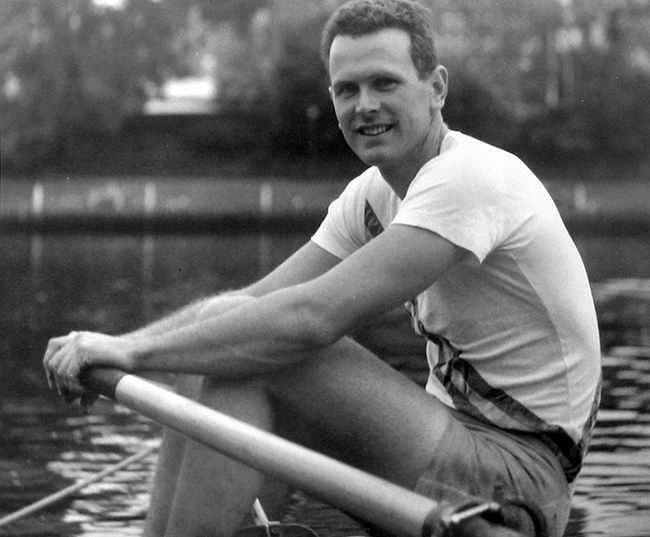
Olympic Sculler Peter Edwards from Melbourne Rowing Club
The highlights of the season were therefore of a domestic nature.
Western Australia were to host the King’s Cup Regatta on the Canning River in May. Athletes from Mercantile Rowing Club, Banks, and Yarra Yarra made up the Eight Oared Crew. Mr. Noel F. Wilkinson had the responsibility of managing the crew. In the final, Victoria produced a mighty effort to challenge the strong New South Wales crew, only to lose by a meagre 0.4 of a second. New South Wales would win all three championship events.
At the women's Interstate Championships, our four finished second in a record field of five but still well behind the dominant NSW crew. Victoria was represented for the first time in the Nell Slatter Cup by Geelong's Joan Beretta. Joan was one of the most promising young scullers to ever come from Geelong. She went missing in 1965 whilst training on the Barwon River. Her body was found a few days later. There was considerable mystery surrounding her tragic death and it received considerable newspaper coverage. Joan had been a success athlete before starting rowing having run the 880 yards at the 1962 Commonwealth Games and holding the national cross country championship.
 Joan Beretta
Joan Beretta
Image from The Canberra Times, 31st July 1965 page 4
In the competition for state premierships, Mercantile Rowing Club for the second time in a row, recorded triple premiership wins, in the Senior, Junior and Lightweight Classifications. Wendouree Rowing Club achieved a second successive victory in the Country Premiership.
Also worth noting this season was the large entry the Champion Eight, with crews from Yarra Yarra, Essendon, and Wendouree Rowing Clubs successfully boating crews for the event.
Wesley College were triumphant in the APS Head of the River Regatta on the Barwon River, defeating Geelong Grammar by half a length in a time of 4:55.8.
As the season drew to a close, attention would turn to preparation for the upcoming series of test races against the New Zealand rowing contingent, which would take place in New South Wales and Victoria.
1965-66
Rowing enthusiasts were spoiled with great spectacles of rowing in Victoria in the year 1966.
This began early on in the season, when the visit of the New Zealand rowing squad proved an outstanding success. The New Zealand team would arrive to contest a series of test races in Australia, the third being at Lake Wendouree, Ballarat. This race, as well as the Twilight Regatta on the Yarra which gave the chance to some local oarsmen to participate, treated members of Victorian Rowing to first class competition on their doorstep.
The series of Test Races and Twilight Regattas ended with New Zealand winning the Ampol Trans-Tasman Trophy with 120 points against Australia’s 93.
Mr. Hubert R Frederico was appointed coach and selector of the Victorian King’s Cup Team. An initial group of twelve men were picked to compete for the Eight-Oared Crew, and when four members of Banks Rowing Club withdrew their applications, the self-appointed King’s Cup Eight would go on to achieve success at this year’s King’s Cup Regatta on the Huon River in Tasmania.
The final would prove to be one of the most thrilling finishes in recent years. Coming into the final 500m of the race, Victoria, New South Wales and South Australia were locked level, and with a final push to the line, Victoria finished half a canvas ahead of New South Wales in a time of 5:54.6. Victoria were also successful in the Single Scull and Lightweight Four, finalising a clean sweep.
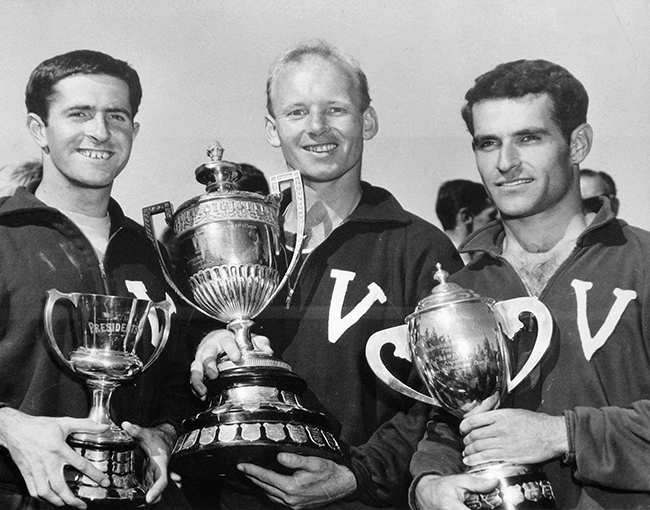
Sculler Jeff Sykes, Stroke of the eight David Boykett and stroke of the lightweight four George Xouris and their silverware
The women's Interstate Championships brought similar joy with the Warrnambool women performing with excellence. The four finished second to New Zealand but were the fastest Australian crew. Warrnambool's Alison Thorne then won the sculling Championships for the Nell Slatter Cup, the first time for a Victorian. This was a great credit to the Warrnambool women and their coach Roy Scutcheon after many years trying.
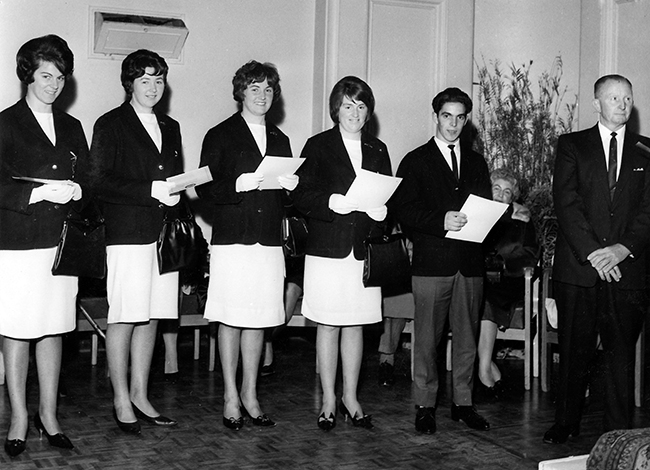
1966 Victorian Four at a Warrnambool reception in their honour
From the left - Alison Thorne, Norma Healey, Patricia Meadth, Val Bertrand, John Arifovic, Roy Scutcheon
The season ended with Banks Rowing Club winning the coveted Senior Premiership, and the Yarra Yarra Rowing Club winning the Junior Premiership. Banks narrowly lost out on the Lightweight Premiership to Mercantile Rowing Club.
At this season’s APS Head of the River Regatta, the fine Scotch College Crew, coached by Mr. Donald R. T. Macmillan, had an outstanding performance to earn a convincing win.
1966-67
This year the King’s Cup Regatta was held in Murray Bridge, South Australia, and saw a brave, but unsuccessful challenge from the Victorian Men’s Eight. The crew rowed impressively at the beginning of both the heat and repechage, but were unable to trouble the great New South Wales Crew in the final, who rowed a powerful race to win by clear water. New South Wales would go on to win each men's Interstate Championship.
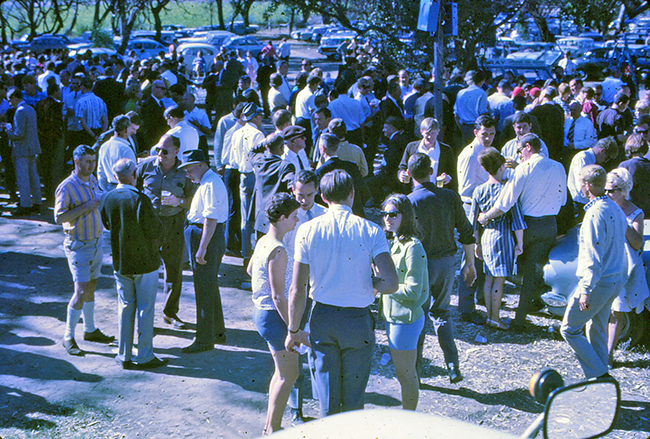
A scene from the King's Cup picnic at Murray Bridge
Normal programming resumed with the Interstate Women's Four Championship win by NSW although Victoria was sending a challenge under the new coach Margaret Mackenzie (then Agnew). However Alison Thorne successfully defended her sculling championships and retained the Nell Slatter Cup.
This year saw the formation of a composite Coxed Four from Mercantile and Melbourne University Boat Club, comprising Stephen Gillon, David G. A. Douglas, John Harry, Graeme Boykett, Tom Daffy, and coach Hubert R. Frederico, in preparation to tour oversees and represent Australia in Canada, the USA and Europe in 1967.
Members of Victorian rowing at the end of this year, eagerly await next season’s King’s Cup and Australian Championship Regatta, which will be held on Lake Wendouree, Ballarat.
At this point, Mercantile Rowing Club had won the State Senior, Junior and Lightweight Premiership, a testament to their consistency in domestic competition this season. Barwon Rowing Club won the State Country Premiership.
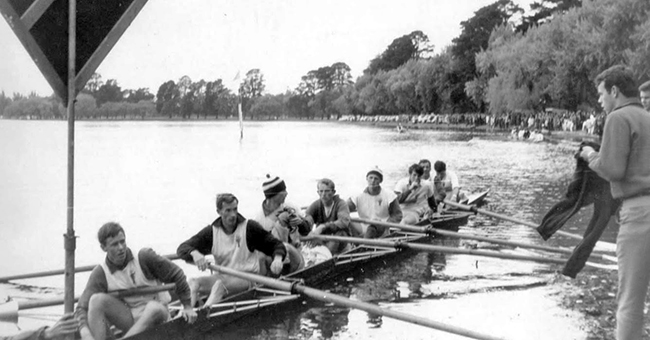
Mercantile's lightweight eight after winning their Victorian Championship - obviously cold weather
Bow: R F Cummings, 2: Tim J Hogan, 3: Ron I Griffiths, 4: Murray B Kellam, 5: Peter J Downey, 6: P V Wood, 7: J A Fox, Str: Geoff A Park, Cox: Cliff Restarick
Scotch College, the only crew to compete in every APS Head of the River since its conception, won the event convincingly in April. It was the centenary regatta.
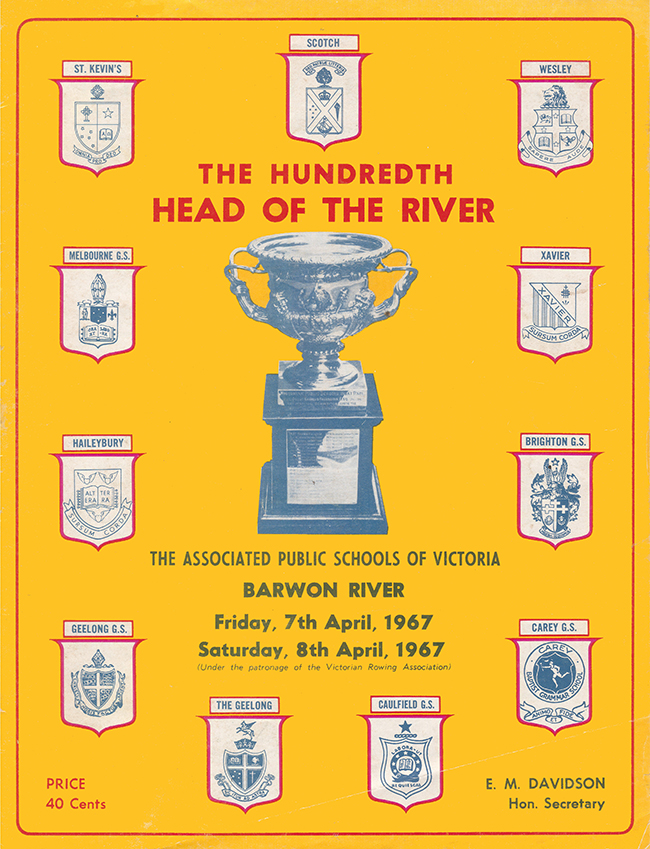
This season saw the election of longstanding servant to Victorian Rowing, Mr. Norman Cairnes, to the position of President of the Australian Amateur Rowing Council.
1967-68
Undoubtedly the highlights of the season were the strong performances of Victorian Oarsmen at international events.
Stephen Gillon, David Douglas and Graeme Boykett from Mercantile along with John Harry from Melbourne University formed a powerful coxed four early in the season. The boat was coxed by Tom Daffy and coached by Hubert R. Frederico, also of Mercantile Rowing Club. The four would go on to perform admirably on an American and European Tour, winning at Canadian Henley and the North American Championships, claiming silver medals at the USA National Championships and competing at the the European Championships. Most importantly, the four was the first to win a FISA Championship in a sweep oared boat at St Catherines. It was a momentus event in Australian rowing.
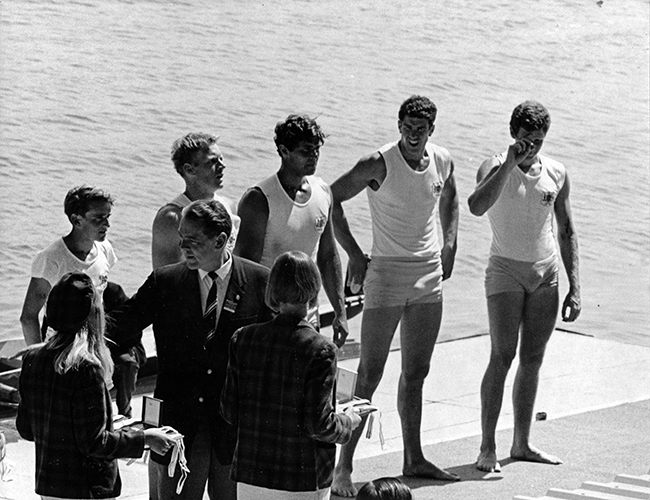
FISA President Thomi Keller presenting the FISA Championship medals to Australia
Tom Daffy, Graeme Boykett, John Harry, David Douglas and Stephen Gillon
The four re-formed after the 1968 King’s Cup and competed for selection to the Olympic Games to be held in Mexico, but unfortunately fell short in their quest. After the failures of Australian Olympic teams in both 1960 and 1964, the Olympic Federation had lost faith in rowing's ability to win. A small rowing team of two crews was selected.
Victorians made up most of the team, consisting of an Eight, Coxed Four, Coxless Pair and Scull picked to represent Australia in New Zealand in competition for the Ampol Trans-Tasman Trophy.
Back home, clubs and race officials were challenged in their capacity to conduct quality racing due to the severe drought in Victoria which afflicted many regatta courses. The King’s Cup was unable to be held on Lake Wendouree, Ballarat, scheduled in March. Swift negotiation and teamwork were carried out with the New South Wales Rowing Association, who on short notice, were able to host the King’s Cup Regatta on the Nepean River in Penrith. The Victorian Men’s Eight rowed a spectacular race and fought tooth and nail with the powerful New South Wales crew over a nail-biting last 250 metres, and just lost out by a canvas.
The Men's National Regatta likewise was moved from Lake Wendouree to Murray Bridge, South Australia. Upon its culmination, the State Senior and Junior Premierships belonged to Mercantile Rowing Club, and Barwon Rowing Club was successful in the State Lightweight and Country Championships.
Melbourne Grammar equalled the course record in their hard fought win against Geelong Grammar School in the APS Head of the River, in a time of 4:31.4 seconds.
1968-69
Victorian rowers and the rest of the nation did not lack for inspiration at the beginning of the season, such was the magnificent display from Team Australia, captained by Olympic veteran Paul Guest at the Mexico City 1968 Olympics. David G. Douglas was the Victorian who featured in a predominantly New South Wales crew to claim a spectacular silver medal in the Men’s Eight. Victorians Paul M Guest and David B Ramage rowed the Coxless Pair to a seventh-place finish. This crew is one of the saddest stories of the Australian Olympic Team. The Games were conducted at an altitude of 2,240m. The crew were unable to have a coach due to Olympic team size restrictions. The pair was highly competitive and clearly a crew capable of winning their event. But in the semi-final and in a winning position one length up, David Ramage succumbed to altitude sickness and their race was lost. Such was their disappointment, they did not want to race the B final. They were forced to do so and under sufferance went to the start without any desire to do well. Half way through the race they changed their mind and rowed through the field to win.
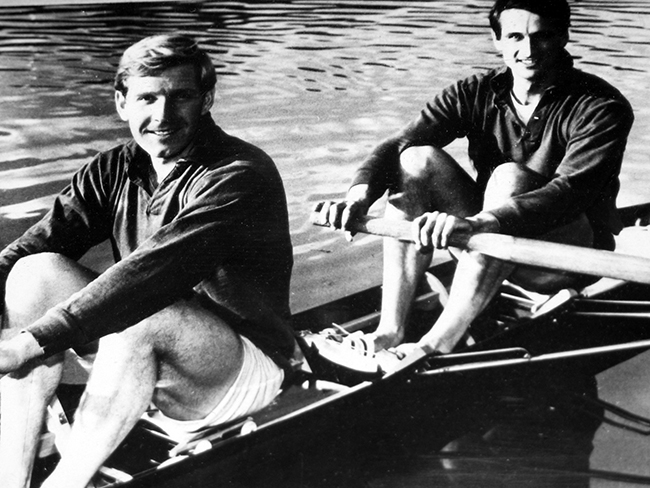
David Ramage and Paul Guest training on the Yarra River
The Victorian Men’s Eight were undoubtedly the underdogs at the Jubilee King’s Cup Regatta on the Burnett River at Bundaberg. The early favourites were undoubtedly the New South Wales crew, six of whom were silver medallists at the Mexico Games. They looked untroubled to win in the heat but were not prepared for the mighty challenge that would be put to them by the brave Victorian crew in the final. Victoria took charge of the race from the first stroke and by the 1500 metre mark led by a boat length, at which point they responded to a late surge from New South Wales to win by a margin of 3.4 seconds in a historic race.
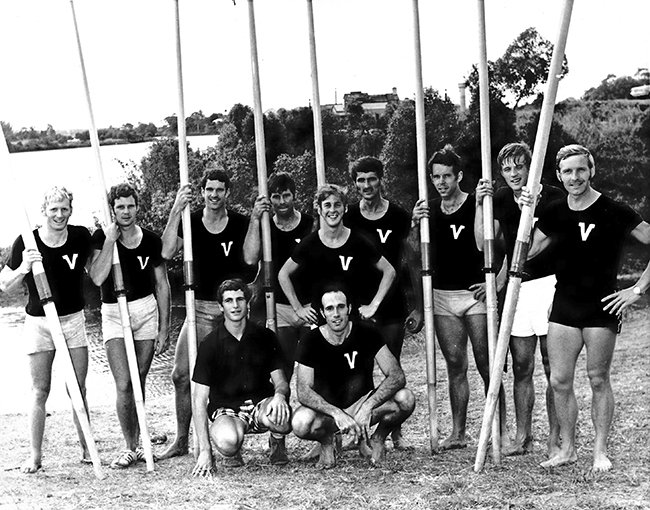
Men's Eight after their win
From the left - Graeme Boykett, Stephen Gillon, David Douglas, John Harry, Geoff Godkin, Paul Guest, Kerry Jelbart, Jack Shanassy, David Ramage, In front - Emergencies Will Liley and David Bishop
The women's Interstate Championships were good. If we include the 1966 event won by New Zealand, Victoria had its first win since 1941! This was a momentous year and great credit to coach Margaret Mackenzie who had developed Victorian women's rowing to a high degree. Also record breaking was that that it was first winning crew in this championship ever to be coached by a woman. The Victorian crew all hailed from the then dominate Victorian women's club of YWCA. The emergency was the exception who came from the Preston club.
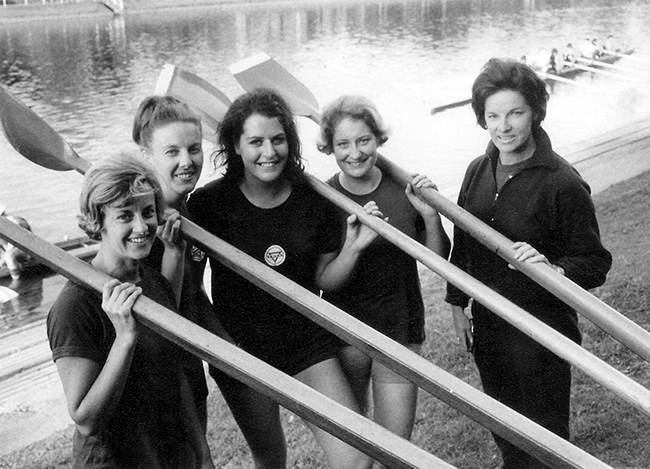
Victorious Victorian crew - the first in 29 years
From the left - Bow: Kath Suhr, 2: Pam Murray, 3: Nanette Geer, Str: Pauline Gilbertson, Cch: Margaret Agnew
The State Senior and Junior Premierships were won this year by Mercantile Rowing Club, whilst Barwon Rowing Club took home the State Lightweight Premiership, and their neighbour Corio Bay claimed the Country Premiership.
Monash University had the privilege of hosting the University Rowing Championships this year on Lake Wendouree. The regatta saw Melbourne win the Oxford and Cambridge Cup won by one length from Sydney. They also claimed the Carlton and United Goblets for Coxless Pairs. Scotch College defeated Melbourne Grammar School at the APS Head of the River Race in a time six-tenths outside the course record.
Footnotes
1. Primary source has been the Victorian Rowing Association annual reports - refer appendix 16
2. Images from the Guerin collection
< previous Chapter 10
> next Chapter 12

